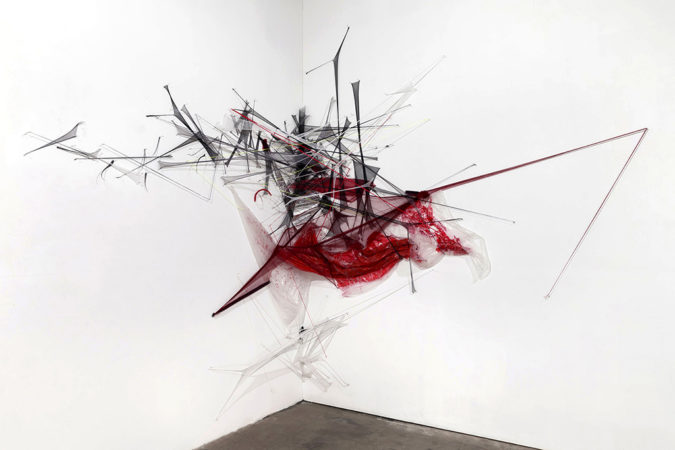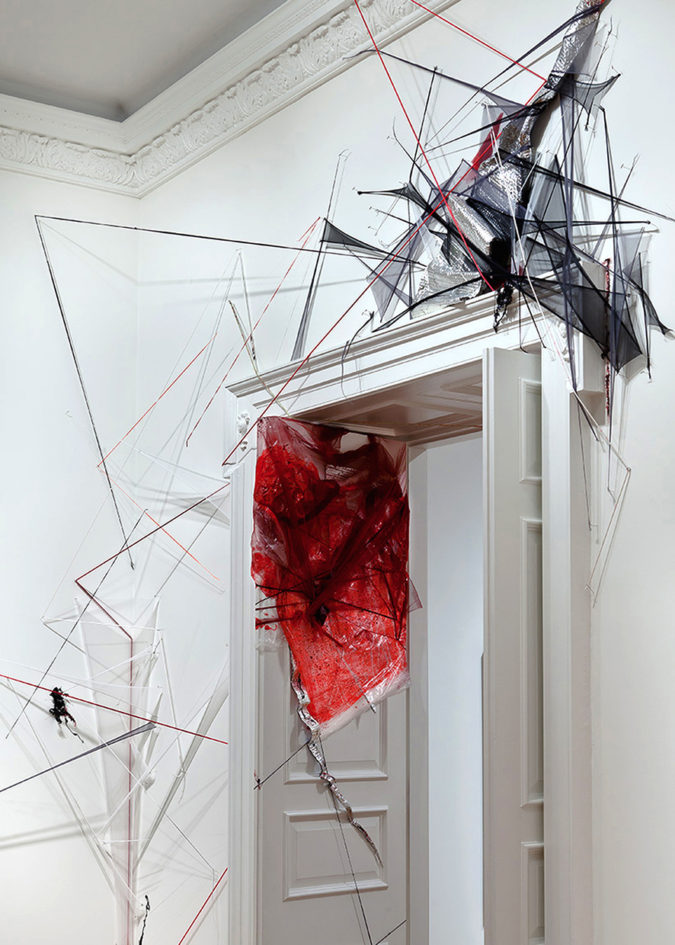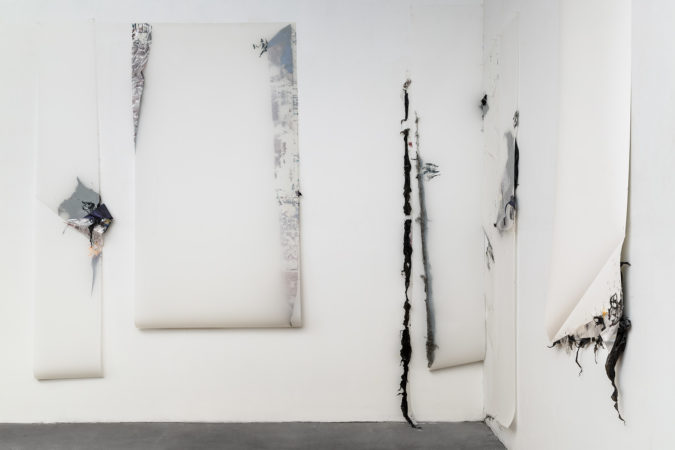Gelah Penn

“The Big Red One” 2013-15, Mosquito netting, plastic tarp, silicone tubing, monofilament, acrylic paint, t-pins, 115 x 165 x 64 inches
Gelah Penn’s work expands on the language of drawing in sculptural space through site-responsive installations and works on paper. Her work can be seen in “PLACE: Monumental Drawings” at Equity Gallery, 245 Broome St., NYC, through June 18. Her work has been exhibited widely, including solo and group exhibitions at the National Academy Museum (New York, NY); Brattleboro Museum (Brattleboro, VT); Itami Museum of Arts and Crafts (Itami, Japan); Bibliotheque Municipale Louis Nucera (Nice, France); Lori Bookstein Fine Art, Sculpture Center, Smack Mellon (New York, NY); Carl Berg Projects (Los Angeles, CA); Real Art Ways (Hartford, CT); and Vox Populi (Philadelphia, PA). Her work is in the collections of the Weatherspoon Art Museum (Greensboro, NC), Columbus Museum (Columbus, GA), Brooklyn Museum Library (Brooklyn, NY) and Cleveland Institute of Art (Cleveland, OH). Reviews and features on her work have been published in Art in America, The New York Times, artcritical.com, The Brooklyn Rail and Sculpture Magazine. Penn has received fellowships from the Marie Walsh Sharpe Foundation, Yaddo and the MacDowell Colony. The artist lives and works in New York City.
Question:
I’m interested in learning about your relationship to the visual effects of weather, how nature moves and shapes form. Your installations often appear as a storm of materials, swirling through air or across doorways. One thinks of erosion and gravity as natural “parallels” to the force and movement embodied in your work. Do you think of such forces explicitly as you make your work?
Answer:
Not explicitly, no. I like the idea of weather as a metaphor for the work, but I probably need to characterize it as psychic weather. These visual storms are really more about interiorized events.
I’m interested in trying to capture and convey an oblique kind of narrative in abstraction. And for me, this narrative is grounded in anxiety. I have a profound interest in film, especially film noir, which informs the work. (All the installation titles are taken from films—Clash By Night, Shadow of a Doubt, Detour, etc.) I think this fascination is rooted in the nature of shadow, both metaphorical and actual. The backstory is that my parents were Holocaust survivors. The work isn’t about that—it’s not descriptive in any way–and their history isn’t my history. But it has an impact, obviously. It’s the disquieting and sometimes chaotic background noise for much of how I think and approach things.

“Where the Sidewalk Ends” (large detail) 2012, Mosquito netting, foiled thermal insulation, plastic & latex tubing, plastic tarp, acrylic paint, t-pins, 169 x 132 x 73 inches
My way in is through the manipulation of almost ephemeral synthetic materials (plastic garbage bags, mosquito netting, monofilament) that I can stretch, knot and tear throughout whatever space they inhabit. These actions allow me to understand and come to grips with the architectural parameters of a given site. I’m completely hopeless when it comes to finding my way in a city or landscape, and that’s probably another reason I’m drawn to installation.

“Big Serial Polyglot Y” 2016, Lenticular plastic, plastic garbage bags, digital prints, acrylic paint, metal staples on mylar and Yupo, Dimensions variable
In my sculptural drawings, the maelstrom slows down and the areas of perceptual incident are compressed into smaller, more isolated segments. There are expanses of untouched foggy layers where these events reside (calm before the storm?) and marks happen both on the surface and behind the translucent plastic I work on. I’m also embedding photographic images of my installation details as a way to reformulate my own history and concerns in this other medium. These two facets of my work—drawing and installation—are continuing to come in closer proximity to each other.
I think there has to be light as well as shadow, so I hope that seductive materials like optical plastic and mylar draw the viewer in and keep her looking for a while.





